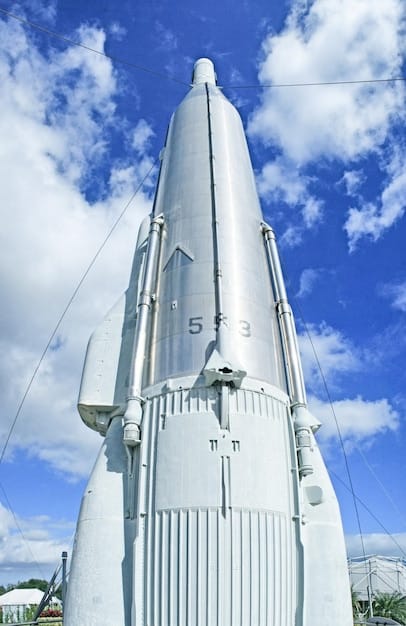Space Tourism in 2025: Is It Ready for US Consumers?

While significant strides have been made in space travel, the readiness of space tourism in 2025 for mainstream US consumers remains a complex interplay of cost, safety, accessibility, and regulatory frameworks, suggesting a nascent but evolving market rather than widespread availability.
The allure of gazing at Earth from orbit, or even stepping foot on another celestial body, has captivated humanity for generations. As 2025 approaches, many are wondering: is space tourism in 2025 finally ready for US consumers? This question delves deep into the technological advancements, economic realities, and regulatory landscapes shaping this burgeoning industry.
The Current Landscape of Commercial Spaceflight
The dawn of commercial spaceflight has been a slow but steady ascent, driven by a handful of visionary companies and evolving technological capabilities. Unlike the governmental endeavors of the past, private enterprises are now at the forefront, pushing the boundaries of what’s possible and rethinking access to space.
For decades, space travel was the exclusive domain of national space agencies, characterized by immense budgets, rigorous training, and limited access. The advent of privately funded ventures like SpaceX, Blue Origin, and Virgin Galactic marks a seismic shift, democratizing access to the final frontier, albeit for a very select few initially.
Key Players and Their Progress
Several companies are vying for a slice of the space tourism pie, each with distinct approaches and technologies. Their progress in recent years has been remarkable, moving from ambitious blueprints to actual, albeit limited, flights.
- Virgin Galactic: Focusing on suborbital flights, Virgin Galactic offers a unique “overview effect” experience, launching passengers to the edge of space for a few minutes of weightlessness and stunning views of Earth. Their SpaceShipTwo system has undergone extensive testing, with commercial operations beginning in 2023.
- Blue Origin: Jeff Bezos’s Blue Origin is developing New Shepard for suborbital tourism, providing similar experiences to Virgin Galactic. They have completed several successful uncrewed and crewed flights, carrying both astronauts and private citizens.
- SpaceX: Elon Musk’s SpaceX is pursuing orbital space tourism with its Dragon spacecraft, aiming for longer duration missions in Earth orbit. They have already facilitated private missions to the International Space Station, showcasing the potential for extended space stays.
These companies are not just building rockets; they are constructing an entirely new ecosystem for space travel, including ground facilities, training protocols, and mission control centers. The emphasis is on safety and reliability, acknowledging the inherent risks of spaceflight.
The evolving regulatory frameworks, largely overseen by the Federal Aviation Administration (FAA) in the US, are also critical. While the FAA primarily focuses on public safety during launch and re-entry, the commercial space industry is advocating for regulations that balance innovation with necessary oversight, paving the way for broader accessibility in the future. The current state is one of cautious optimism, with significant milestones achieved, yet many challenges remain before space tourism becomes a common endeavor for US consumers.
Costs and Accessibility for the Average Consumer
One of the most significant barriers to widespread space tourism for US consumers remains the exorbitant cost. While prices are projected to decrease over time with increased demand and technological efficiencies, 2025 still places these experiences firmly in the luxury market. Understanding these financial hurdles is crucial to assessing the readiness of the industry for a broader audience.
Currently, a ticket for a suborbital flight can run into hundreds of thousands of dollars, while an orbital journey can cost millions. These figures are well beyond the reach of the average American household, indicating that initial space tourists will primarily be ultra-high-net-worth individuals, celebrities, or researchers. The economics of space travel are complex, involving massive infrastructure investments, advanced material costs, and highly specialized personnel.
The Million-Dollar Question: Will Prices Drop?
The trajectory of price reduction in space tourism is a central point of discussion. Historical parallels, such as the early days of air travel, suggest that costs decline significantly as technology matures and economies of scale are achieved. However, the unique challenges of spaceflight present a steeper cost curve.
- Suborbital Flights: While still expensive, suborbital flights are likely to become more accessible first. Some analysts predict prices could drop to tens of thousands of dollars within the next decade or two, but it’s unlikely to happen by 2025.
- Orbital Flights: Orbital tourism involves significantly more complex technology and longer durations, making substantial price reductions more challenging in the near term. The specialized nature of the training and life support systems required for extended stays in space contributes to the high cost.
- Technological Advancements: Reusable rocket technology, being pioneered by SpaceX and Blue Origin, is a key driver for cost reduction. By reusing expensive components, the cost per launch can be dramatically lowered, potentially translating to more affordable tickets in the long run.
Even with these advancements, the market for space tourism in 2025 will likely cater to a niche clientele. Companies are exploring various business models, including fractional ownership or tiered experiences, to broaden the appeal. However, for the average US consumer, space tourism in 2025 will primarily remain a spectacle rather than a personal experience, with accessibility limited to those with significant disposable income.
Safety Regulations and Industry Standards
Safety is paramount in space travel, and for space tourism to flourish, robust regulatory frameworks and industry-wide safety standards are indispensable. The inherent risks of launching humans into space necessitate stringent oversight, ensuring the protection of passengers and the general public. In the United States, the Federal Aviation Administration (FAA) plays a crucial role in overseeing commercial spaceflight operations.
The FAA’s Office of Commercial Space Transportation (AST) is responsible for licensing and regulating commercial launch and re-entry operations. Their primary mandate is to protect public safety, property, and national security. For space tourism, this includes ensuring that launch and re-entry vehicles meet design and operational safety criteria. However, current regulations offer a degree of “informed consent” for space tourists, meaning that participants must be aware of and accept the risks involved in space travel.

Evolving Regulatory Landscape
The regulatory environment for space tourism is still evolving, trying to keep pace with rapid technological advancements. Unlike traditional aviation, which has a century of safety records and established protocols, commercial spaceflight is a relatively new frontier. This creates a delicate balance between fostering innovation and ensuring adequate safety measures.
- Launch and Re-entry Safety: The FAA’s focus is currently heavily on the safety of the launch and re-entry phases, which pose the greatest risks to the public. This involves rigorous testing, safety analyses, and operational procedures to mitigate potential hazards.
- Crew and Passenger Safety: While the FAA oversees public safety, regulations concerning the safety of the crew and “spaceflight participants” (i.e., tourists) are less prescriptive. The current approach allows companies more flexibility in designing their internal safety protocols, provided passengers are fully informed of the risks.
- Industry Self-Regulation: The commercial space industry itself is actively involved in developing voluntary safety standards and best practices. This collaborative approach, often driven by organizations like the Commercial Spaceflight Federation, aims to build public trust and ensure long-term viability.
As 2025 approaches, it’s expected that regulatory discussions will intensify, possibly leading to more comprehensive rules regarding passenger training, medical requirements, and in-flight emergency procedures. The goal is to move towards a more mature regulatory framework that supports a growing industry while maintaining the highest safety standards. For US consumers, the readiness of space tourism hinges significantly on their confidence in these safety measures and the industry’s commitment to continuous improvement.
Training and Preparation for Space Tourists
Becoming a space tourist isn’t as simple as booking a flight. Even for suborbital journeys, a significant level of training and preparation is required to ensure passengers are physically and mentally ready for the unique challenges of spaceflight. This rigorous preparation is a critical component of the space tourism experience, designed to maximize safety and enjoyment.
The training protocols vary depending on the type of spaceflight. Suborbital flights, while shorter in duration, still expose individuals to high G-forces during ascent and re-entry, as well as a period of weightlessness. Orbital flights demand even more extensive preparation, addressing prolonged periods in microgravity, living in a confined environment, and potential medical considerations.
What Does Space Tourist Training Involve?
Prospective space tourists undergo a multi-faceted training regimen, often tailored to the specific spacecraft and mission profile. While not as intensive as astronaut training, it still demands commitment and physical readiness.
- Medical Screening: A comprehensive medical evaluation is the first step to ensure individuals are healthy enough for space travel. Conditions like heart disease, severe back problems, or uncontrolled diabetes could be disqualifying factors due to the extreme forces involved.
- G-Force Tolerance Training: Passengers are exposed to G-forces in centrifuges or specialized aircraft to simulate launch and re-entry conditions, helping them understand and adapt to the sensations. This reduces anxiety and ensures they can safely withstand the pressures.
- Weightlessness Familiarization: Training often includes parabolic flights inside “vomit comet” aircraft, which create brief periods of microgravity. This helps passengers learn how to move, react, and manage their bodies in a weightless environment.
- Emergency Procedures and Safety Briefings: Comprehensive briefings on emergency protocols, safety features of the spacecraft, and communication procedures are mandatory. Understanding evacuation routes, oxygen mask deployment, and other critical actions is essential.
- Orientation and Environment Adaptation: For orbital missions, training extends to living in the space environment, including hygiene, food preparation, and operating within the spacecraft’s systems.
By 2025, the industry will have refined these training programs, making them more efficient but no less thorough. While basic fitness is a prerequisite, the aim is not to turn tourists into astronauts, but to equip them with the necessary knowledge and psychological preparedness. The readiness of US consumers for space tourism isn’t just about the availability of flights, but also their willingness and ability to undergo this specialized preparation.
Ethical and Environmental Considerations
As space tourism inches closer to mainstream availability, ethical and environmental considerations become increasingly pertinent. While the allure of space is undeniable, the potential impact of frequent launches on Earth’s atmosphere and the broader cosmic environment cannot be ignored. Responsible development of space tourism requires a careful balancing act between innovation and sustainability.
One of the primary environmental concerns revolves around rocket emissions. Launches release greenhouse gases, black carbon, and other pollutants into the atmosphere, which can contribute to climate change and ozone depletion. While the current frequency of commercial launches is relatively low, a significant increase in space tourism flights could exacerbate these issues, necessitating the development of cleaner propulsion technologies.
Addressing the Footprint of Space Travel
The industry is beginning to grapple with its environmental footprint, exploring various avenues to mitigate negative impacts. This includes research into more sustainable fuels and propulsion systems, as well as operational efficiencies.
- Emission Reduction: Companies are investigating the use of cleaner propellants like liquid oxygen and methane, which produce fewer harmful byproducts compared to traditional kerosene-based fuels. Research into bio-fuels for rockets is also underway.
- Space Debris: The increasing number of launches, including those for tourism, contributes to the growing problem of space debris. Collisions with debris can create even more fragments, posing a threat to operational satellites and future missions. Responsible operators are focusing on designing missions that minimize debris creation and considering de-orbiting plans for spent rocket stages.
- Upper Atmospheric Impacts: The long-term effects of rocket emissions in the upper atmosphere are still being studied. Understanding these impacts is crucial for developing appropriate environmental regulations and best practices.
Beyond environmental concerns, ethical questions also arise. Should access to space be limited to the ultra-wealthy? What are the implications of commercializing what was once a realm of scientific exploration? These philosophical debates are as crucial as the technical ones. By 2025, the industry will likely be under increasing scrutiny to demonstrate its commitment to environmental stewardship and equitable access, making these factors central to the perceived readiness and acceptance of space tourism among US consumers.
Future Projections and Long-Term Vision
Looking beyond 2025, the long-term vision for space tourism is far more ambitious than mere suborbital hops. While the immediate future focuses on short, high-priced experiences, the industry’s ultimate goal is to enable broader access to space, including orbital hotels, lunar excursions, and even travel to Mars. These projections, though futuristic, are driving current research and development efforts, laying the groundwork for a truly transformative era of space travel.
The progression from initial “adventure tourism” to a more established industry will likely mirror the development of commercial aviation. Early flights were exclusive and expensive, gradually becoming more affordable and accessible to the masses. The key differentiator for space is the technological complexity and inherent risk, which necessitates a more gradual evolution.
Beyond Earth Orbit: Lunar and Martian Aspirations
While 2025 is about building foundational capabilities, the long-term vision extends far beyond low Earth orbit. Several companies and national space agencies are actively pursuing lunar and Martian missions, which fundamentally change the scope of space tourism.
- Orbital Space Hotels: Concepts for orbiting space stations designed to host tourists for extended stays are already in development. These would offer unparalleled views, microgravity experiences, and potentially research opportunities for private citizens. Modules designed for habitation are being tested by companies like Axiom Space.
- Lunar Tourism: Companies like SpaceX envision lunar flybys as a precursor to actual lunar landings for private individuals. The “dearMoon” project, for example, aims to send artists and creatives on a trip around the Moon by the mid-2020s.
- Mars Exploration: The ultimate frontier for many, Mars travel, remains a distant but tantalizing prospect for space tourism. While full-scale tourism is decades away, the technological advancements required for human missions to Mars will pave the way for future private expeditions.
The realization of these long-term visions hinges on several critical factors: continued technological breakthroughs, significant reductions in launch costs, and the establishment of robust in-space infrastructure. Furthermore, international cooperation and the development of space laws will be essential for managing traffic, resources, and potential challenges in orbits and on celestial bodies. For US consumers, the readiness of space tourism in 2025 serves as a prelude to a future where the notion of vacationing off-world might transition from science fiction to an extraordinary, yet attainable, reality.
The Psychological and Cultural Impact on Society
The emergence of space tourism, even in its nascent stages, carries significant psychological and cultural implications for society, particularly for US consumers. Beyond the economic and technological facets, the ability for private citizens to venture into space alters our perception of human capability, our place in the cosmos, and the boundaries of human experience. This profound shift can inspire a new generation, influence popular culture, and even reshape our understanding of environmentalism from a global perspective.
The “overview effect”—the cognitive shift reported by astronauts who view Earth from space, leading to a deeper appreciation for its fragility and interconnectedness—could, theoretically, extend to space tourists. While these experiences are brief for suborbital flights, even a fleeting glimpse can be transformative, fostering a greater sense of environmental stewardship and global unity among those who experience it. For those who remain on Earth, space tourism serves as a powerful symbol of progress and technological prowess.
Shaping Future Aspirations and Cultural Narratives
The visual spectacle of commercial spaceflights, often livestreamed and widely publicized, contributes to a collective human experience. It fuels aspirations, particularly among younger generations, for careers in STEM fields and reignites a sense of wonder about the universe. This cultural resonance is crucial for the long-term vitality of the space industry.
- Inspiration and Education: Space tourism acts as a tangible manifestation of scientific and engineering achievement, inspiring educational initiatives and encouraging engagement with space exploration. It makes the abstract concept of space feel more real and accessible.
- Pop Culture Influence: As more private citizens travel to space, their narratives will inevitably seep into books, films, and art, creating new genres and perspectives on human existence. This will further normalize space as a frontier for civilian activity rather than solely a domain of government astronauts.
- Democracy of Experience: While currently exclusive, the eventual broadening of access to space tourism could foster a sense of shared human experience, albeit one that begins with a select few. The tales of these early voyagers will shape public perception and increase demand.
- Global Unity Perspective: Seeing Earth as a single, fragile blue marble, without political borders, can foster a more unified global perspective among those who travel. This “planetary consciousness” could have long-term positive effects on international relations and environmental efforts.
By 2025, the cultural impact of space tourism, even if limited to a small number of consumers, will be felt through media representation and public discourse. It reinforces the idea that space is no longer just for government-selected astronauts, but a potential destination for humanity. This psychological and cultural embracing of space travel will be a significant indicator of whether space tourism is truly “ready” for US consumers, not just technologically, but as an accepted and aspirational part of modern life.
| Key Point | Brief Description |
|---|---|
| 🚀 Commercial Readiness | Suborbital flights available, orbital gaining momentum, but still nascent for broad consumer access. |
| 💸 Cost & Access | Exorbitant prices limit access to ultra-wealthy; significant price drops unlikely by 2025. |
| 🛡️ Safety & Regulation | FAA oversight focuses on public safety; passenger safety relies on informed consent and industry standards, which are evolving. |
| 🌍 Environmental Impact | Concerns about emissions and space debris are growing, pushing for cleaner tech and responsible practices. |
Frequently Asked Questions
▼
No, it is highly unlikely. While pricing strategies are evolving, the cost of space tourism, even for suborbital flights, remains in the hundreds of thousands of dollars. Significant reductions to make it accessible to the average consumer are not anticipated by 2025 due to technological complexities and high operational costs.
▼
Even for suborbital flights, space tourists undergo significant preparation including medical screening, G-force tolerance training using centrifuges, and weightlessness familiarization in specialized aircraft. They also receive comprehensive briefings on emergency procedures and safety protocols to ensure readiness for the journey.
▼
Safety is a primary concern, with the FAA overseeing public safety during launch and re-entry. However, regulations specific to passenger safety are still evolving, relying on informed consent and industry self-regulation. While companies prioritize safety, the framework is less established than traditional aviation, emphasizing an acceptance of inherent risks.
▼
Virgin Galactic and Blue Origin are prominent for suborbital experiences, offering brief journeys to the edge of space. SpaceX is focused on orbital tourism, facilitating longer duration missions, including trips to the International Space Station for private citizens. These companies are the main players catering to US (and international) clients.
▼
Increased launches contribute to rocket emissions (greenhouse gases, black carbon) and space debris. The industry is responding by exploring cleaner propellants like liquid oxygen and methane, and focusing on reusability to reduce waste. Efforts are made to minimize debris creation and promote sustainable operational practices.
Conclusion
As we assess the readiness of space tourism for US consumers in 2025, a nuanced picture emerges. While the dream of civilian space travel has undeniably moved from science fiction to ambitious reality, it remains a highly exclusive domain. Companies like Virgin Galactic, Blue Origin, and SpaceX have made remarkable strides, demonstrating the technical feasibility of commercial spaceflight through successful suborbital and orbital missions. However, the prohibitive costs, coupled with evolving but not fully mature regulatory frameworks and the inherent risks of space travel, mean that widespread accessibility for the average US consumer is still some years away. By 2025, space tourism will primarily cater to an ultra-luxury market, serving as a powerful symbolic stepping stone towards a future where humanity’s reach truly extends beyond Earth. The cultural and psychological impact, however, is already beginning to take hold, inspiring new generations and shifting our collective perception of our place in the universe.





